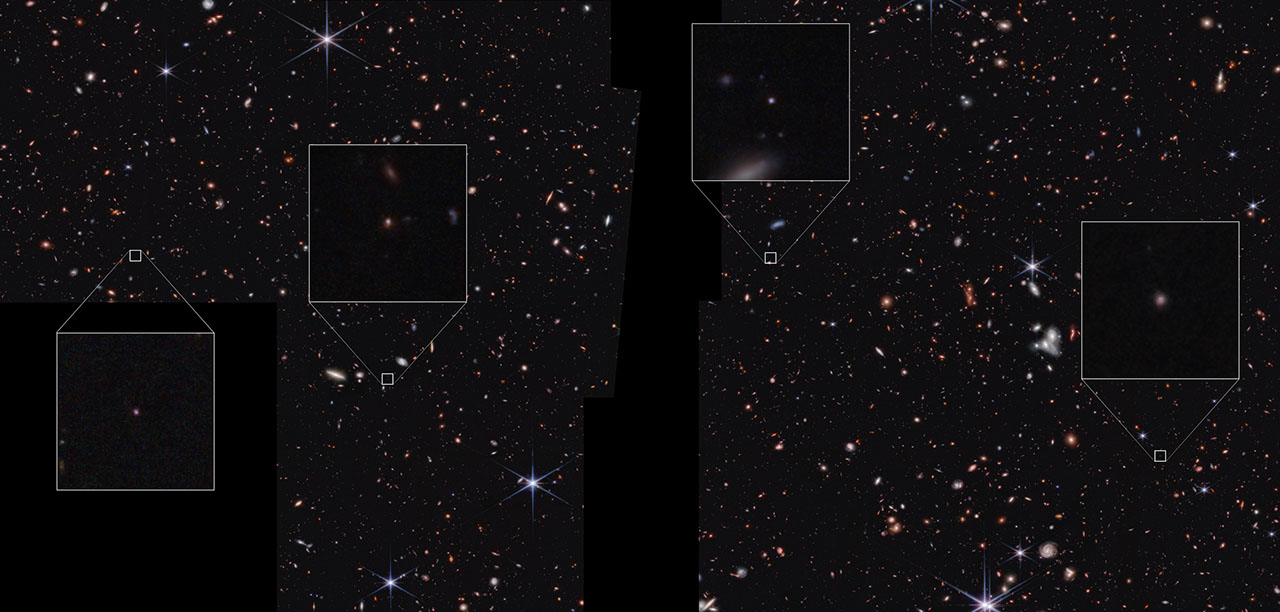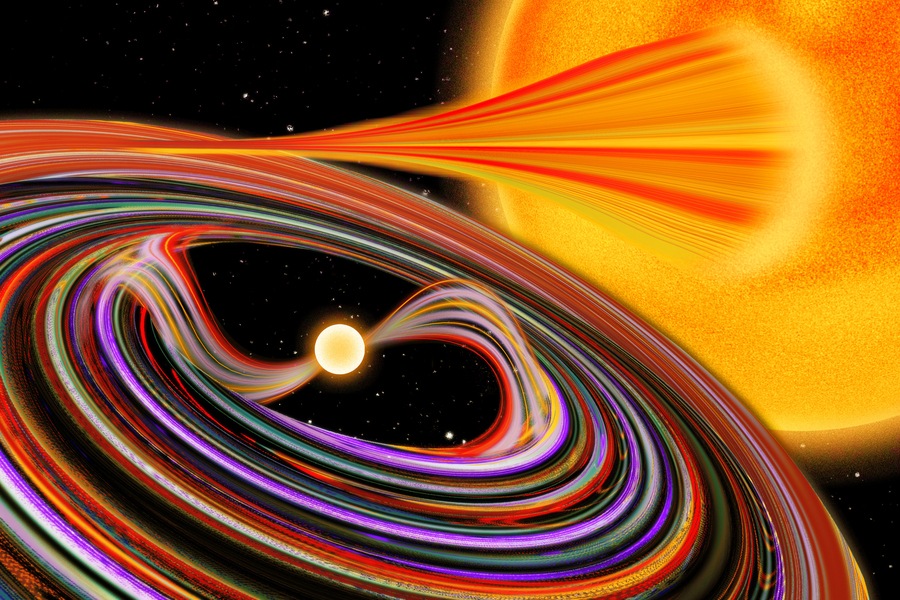It's funny, the things you notice hanging upside down in space.
Astronaut John Mace Grunsfeld remembers a quirky discovery back in 1999. He had just arrived at the Hubble Space Telescope and climbed out of the airlock of Space Shuttle Discovery to begin a servicing mission. Clinging to a handrail running down the side of Hubble's gleaming exterior, he ran his eyes over the blue planet 350 miles below and tried not to think too hard about the yawning starry expanse behind him. The astronaut, Hubble, and Discovery, connected together, raced around Earth at 17,000 mph.
That's when he noticed the handprints.
"The outside surface of Hubble is covered with them—scuff marks and other signs of handling by astronauts," says Grunsfeld.
A ScienceCast video explores the deeper meaning of superficial 'handprints' on Hubble.
Astronauts visited the orbiting telescope five times since it was launched in April 1990, conducting 23 spacewalks to repair and improve it. The "handprints" come from oil and silicon on the astronauts' gloves, which make an impression on Hubble's exterior foil. Initially invisible, these residues darken over time as they are exposed to solar ultraviolet radiation.
The prints Grunsfeld saw are more than chemical scuff marks, though.
"They are a symbol," he says, "of a unique human-robotic partnership."
Hubble's designers intended for astronauts to lay hands on Hubble. The telescope is festooned with knobs and handrails, hinged doors, and crawl spaces fit for astronauts to visit and tinker. This has allowed Hubble to do something no other spacecraft has done before—evolve.
When Hubble left Earth 25 years ago it was equipped with reel-to-reel data recorders, 1980s-era microprocessors, and some of the earliest digital cameras. Fast forward to the present: Almost every scientific instrument onboard the telescope has been replaced at least once. Hubble now has solid-state recording devices, upgraded computers, and astronomical detectors that far outperform the older technology it originally took to space. Astronauts have also replaced the telescope's aging solar arrays, batteries, gyroscopes, some reaction wheels and fine guidance sensors. Keeping pace with technological advances on its home planet, Hubble is very much a creature of the 21st century.
Astronauts have done more than just upgrade Hubble. They have also saved it.
The first time was in 1993. When Hubble reached orbit, images revealed that the telescope’s mirror was flawed. It suffered from a distortion called spherical aberration. Hubble could still take pictures of the cosmos but not with the sensitivity or resolution its designers envisioned.
"The first servicing mission in 1993 took care of that," says Grunsfeld. That December, seven astronauts flew to the telescope onboard Space Shuttle Endeavour. Over a period of 11 days, the crew conducted 5 spacewalks and used more than 100 specialized tools, many of which were invented specifically for the mission. They installed corrective optics, a new main camera, new solar arrays, and two new gyro packages.
Not everything went smoothly.
During the mission, spacewalkers Story Musgrave and Jeff Hoffman opened a pair of service doors to swap out gyros but could not get them closed again. The door bolts would not reset. Engineers on Earth speculated that when the doors were opened, a temperature change caused them to expand or contract.
"They ended up using a make-shift ratchet to squeeze those doors together," recalls Grunsfeld. "That was a very bad idea. It could have broken Hubble, but at the time, they didn't know that. Anyway, they squeezed the doors together using brute force."
Evidence of the wrestling match is evident today in a confusion of 'handprints' and scuff marks around the doors. The marks tell a silent story of ingenuity, risk, and triumph.
"Without that first servicing mission, Hubble would have been a nice telescope but not a great one," opines Grunsfeld. "We would not have measured the edge of the universe, validated black holes, or discovered dark energy. The fingerprints of astronauts are all over those advances."
Another difficult moment came in the late 1990s. Mission planners were growing nervous as Hubble's gyros unexpectedly started to fail—one in 1997, another in 1998, and a third in 1999. If one more gyro went offline, the telescope would not be able to point accurately.
The whole telescope was on the razor's edge of failure as Grunsfeld and six other astronauts readied themselves for Servicing Mission 3A. Indeed, just weeks before their Space Shuttle, Discovery, was scheduled to launch, a fourth gyro failed and Hubble science came to a screeching halt.
"We felt some urgency to get up there and fix the telescope," he recalls.
It would be Grunsfeld's first mission to Hubble, the first time he touched the telescope, and the first time he added his own prints to those of his predecessors. Discovery lifted off on Dec. 20, 1999. During the week-long mission, the crew installed new gyros, replaced a Fine Guidance Sensor (FGS) and swapped out the main computer. The new computer was 20 times faster and had six times the memory of the one it replaced.
"Coming out of that mission, we left the telescope in pretty good shape," he says. "We saved Hubble."
Little did he know, that rescue merely set the stage for a more thrilling one to come.
In 2000, engineers working on Hubble noticed a curious anomaly: The telescope's batteries were not charging as quickly as they should. It was a tiny effect, measured in units as small as micro-ohms, but over time it could add up to catastrophe: Hubble could "go dark" as early as 2003. With detective work that insiders still remember with awe 15 years later, engineers figured out the problem. There was a subtle ground fault in the telescope's Power Control Unit—or PCU.
The PCU is essentially a bank of relays that routes power from Hubble's solar arrays to its batteries and other systems. It is a very complicated device, and the only way to service it is to turn it off. Completely. No power to Hubble at all.
"This was kind of a big deal," says Grunsfeld. "If we didn't repair it, Hubble would die in about 3 years. On the other hand, if we tried to fix it, Hubble might die right away. Powering down Hubble had never been done before. Hundreds of relays would be switched to their powered-off state. A clock would be ticking because Hubble would get cold. There was a window of only a few hours to do the repairs because overnight Hubble would freeze,the optical bench would warp, and Hubble would no longer be functional."
NASA decided to go for it, and Grunsfeld started training for the most challenging mission of his career: Hubble Servicing Mission 3B. Flying Space Shuttle Columbia one last time before the disaster of 2003, the mission's crew would ultimately invent new tools, new training procedures, and new repair techniques to tackle the PCU problem. "We really upped our game," says Grunsfeld.
Around NASA, many experts worried about the PCU repair. Could it really be done? The astronauts themselves were worried. Sleepless in space, Grunsfeld and Rick Linnehan woke up early on March 2, 2002, and started prepping for their spacewalk more than two hours ahead of schedule. NASA prepared to cut power to the telescope as soon as they were ready to step outside.
"Keep in mind that as soon as power was off, we were on a ticking clock," says Grunsfeld. "There was a real sense of urgency, no question about it."
Immediately something went wrong: "Astronauts Mike Massimino and Jim Newman were preparing us to go outside," he says. "When Jim released me from the latches on the wall of the airlock, he noticed that my backpack was wet. A valve inside my spacesuit had failed and was leaking water. That's very bad. Had I gone outside, that water would have frozen, cracked an airline, and I could have been killed."
Suddenly the spacewalkers were behind schedule. Tick. Tock. Tick. Tock. Working quickly, astronauts in the airlock helped Grunsfeld out of his suit and assembled a new one from parts of other suits that fit him.
"In less than two hours—record time, by the way—we were able to get me back into a spacesuit. By the time we started the EVA, we were about two hours late. There was some mild panic on the ground because Hubble had been cooling off," he recalls.
The astronauts, however, were even cooler.
"You might think, 'Oh gosh, Rick and I must have been in a panic because we had already lost two hours of the day,'" says Grunsfeld, "But no. We went out the hatch as if everything was completely normal. We had that kind of focus from the training we had done. As soon as I was in the spacesuit again, I totally forgot that we had had all of those earlier problems. Rick and I went out and did it in 6.5 hours, exactly as we had trained."
The PCU was repaired, and the telescope powered up in good condition. Hubble was saved again.
NASA retired its Space Shuttle fleet in 2011, but not before one last visit to a telescope Grunsfeld now considered "an old friend."
Originally, plans called for Hubble to be serviced in February 2005, but the Columbia tragedy of 2003 changed everything. A trip to Hubble was deemed too risky, and for a while, it seemed that the telescope might never be serviced again.
"That would have spelled the end of Hubble," says Grunsfeld. "The telescope's batteries were 13 years old, and they were beginning to fail. Without replacements, the mission would have ended as early as 2007."
And it would have ended, except for the ensuing public outcry. Not only did astronomers wish to save Hubble but also millions of ordinary people did too. For more than two years, 2004-2006, school children wrote letters to the President, public hearings were held in Congress, and the "human connection" to Hubble became as clear as the glove-marks on its gleaming foil.
NASA reconsidered.
In May of 2009, Space Shuttle Atlantis blasted off for one last mission to Hubble. On the ground below, Space Shuttle Endeavour waited on the launch pad, ready to fly to the rescue if the crew of Atlantis got into trouble. This is how NASA managed the risk of flying the soon-to-be-retired spacecraft.
"By 2009 a ton of things were going wrong on Hubble," says Grunsfeld. "We did 5 EVAs to fix those things."
As usual, the astronauts had to invent new procedures and do the unprecedented—"like removing hundreds of tiny screws in bulky space suits," he recalls. They replaced batteries, swapped out all six gyros (again), installed a new Fine Guidance Sensor, repaired two of Hubble's scientific instruments and completely replaced two others. Mindful that astronauts might never visit Hubble again, the spacewalkers installed a soft-capture mechanism that would allow a future robotic spacecraft to grapple Hubble to ensure a safe conclusion to its operational lifespan.
For one last time, Grunsfeld saw the marks of the Hubble repair crews, the handprints of 16 spacewalkers: Story Musgrave, Jeff Hoffman, Kathryn Thornton, Thomas Akers, Mark Lee, Steve Smith, Greg Harbaugh, Joe Tanner, Mike Foale, Claude Nicollier, Rick Linnehan, James Newman, Mike Massimino, Andrew Feustel, Michael Good, and Grunsfeld himself.
"Leaving Hubble in 2009 was bittersweet," says Grunsfeld. "I was sad to see my old friend go. However, as a crew we were thrilled that we had accomplished all of our goals and a little more, sending Hubble off in the best shape ever."
Current estimates suggest that Hubble will continue doing great science until 2020 and possibly longer. All thanks to the human touch.


































